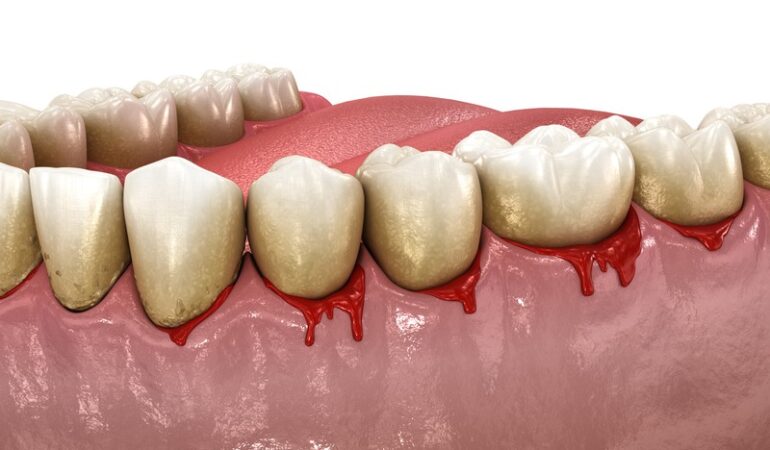Your gums do much more than just hold your teeth in place. Healthy gums mean healthy teeth, and together, they help you chew, talk, and smile with confidence. When gums recede, they expose the roots of your teeth, which can cause pain, sensitivity, and—if left untreated—lead to tooth loss. Gum grafting is a dental procedure that repairs receding gums, but is it the right choice for you?
What Is Gum Grafting?
Gum grafting is a surgical technique performed to restore lost or receding gum tissue. This technique usually involves taking a small amount of tissue from another part of your mouth (often the roof of your mouth or another surrounding area) and attaching it to the area where your gums have receded. The goal? To protect exposed tooth roots, reduce sensitivity, and create a healthier gum line. Dentists may use different methods depending on what your mouth needs.
-
Connective Tissue Grafts: Tissue taken from under the surface of your palate.
-
Free Gingival Grafts: Tissue taken directly from the roof of your mouth.
-
Pedicle Grafts: Tissue from gum areas next to the receding gum.
Signals You Might Need a Gum Graft
Your gums might not shout for help, but you can spot some early warnings if you know what to look for. If you notice these signs, it’s time to check in with your dental professional:
-
Teeth look longer than before
-
Sharp or growing sensitivity to hot and cold
-
Visible tooth roots
-
Frequent gum bleeding during brushing or flossing
-
Loose teeth
-
Gum inflammation or swelling
Why Gums Recede
Gum recession doesn’t happen overnight. It’s often a gradual issue, influenced by a mix of factors like genetics, aggressive brushing, gum disease, poor dental habits, grinding your teeth, hormonal changes, and even certain health conditions. On top of physical factors, lifestyle choices like tobacco use can speed up gum loss.
Key Causes of Gum Recession
-
Poor oral hygiene or skipped dental cleanings
-
Brushing too hard
-
Plaque buildup and gum disease
-
Misaligned teeth or bite
-
Clenching or grinding your teeth
-
Smoking or tobacco use
-
Genetics—sometimes, you inherit the risk
Benefits of Gum Grafting
Gum grafting is more than just repairing your smile. This procedure addresses both health and cosmetic concerns. Here’s a closer look at the benefits:
Reduces Tooth Sensitivity
When roots are exposed, eating or drinking hot, cold, or sweet foods can be uncomfortable. A graft covers the sensitive areas, shielding the nerves and helping make mealtimes enjoyable again.
Helps Prevent Further Gum Loss
Once recession starts, it can quickly get worse. Gum grafting acts as a strong defense, halting the progress of gum loss and keeping bacteria at bay where they love to hide.
Boosts Your Smile’s Appearance
If you feel self-conscious about “long” teeth or uneven gums, grafting can give your gums a natural, healthy look. It brings balance back to your smile and can improve your confidence.
Prevents Root Decay and Damage
Exposed roots are more likely to develop cavities because they aren’t protected by enamel. By adding tissue back, gum grafting helps keep roots healthy and reduces the risk of root decay or tooth loss.
Improves Overall Oral Health
Healthy gums are foundational to strong teeth. Gum grafting can make brushing and flossing more comfortable, helping you maintain better oral hygiene long-term.
Are You a Good Candidate for Gum Grafting?
If you’re dealing with receding gums and the issues that come with them, you might be wondering if this procedure is right for you. Ideal candidates usually:
-
Have visible gum recession
-
Struggle with tooth sensitivity
-
Want to improve their smile’s appearance
-
Have generally healthy teeth and no unmanaged major health concerns
-
Are willing to commit to thorough oral hygiene before and after surgery
Your dentist will look at your gums, ask about your medical history, and help you weigh the pros and cons. To be sure, an evaluation is key, since each mouth is unique.
How Gum Grafting Is Performed
Most gum grafts are performed in a dental office with local anesthesia to numb the area. Here’s what typically happens:
-
The dentist prepares the area that needs grafting.
-
Tissue is collected from the selected donor site.
-
The tissue is stitched in place where your gums have receded.
-
You may get sutures or a special dressing to protect the area as it heals.
Recovery Timeline and Tips
-
Expect mild discomfort and swelling for a few days.
-
Eat soft foods—think yogurt, eggs, or mashed potatoes—for the first week or so.
-
Stick to gentle brushing and avoid the graft area until given the all-clear.
-
Take any prescribed medication as directed.
-
Be patient—healing can take a few weeks, but most people return to normal eating quickly.
What Results Can You Expect?
Most people notice reduced sensitivity, improved gum coverage, and a more balanced smile after a few weeks. Results are usually long-lasting, especially if you keep up with daily brushing, flossing, and regular dental visits. Gum tissue heals relatively quickly, so visible improvements often show up in a few weeks, even if the full healing process takes a couple months.
Risks and Things to Consider Before Surgery
While gum grafting is considered a safe and relatively straightforward dental procedure, it’s still surgery. A few possible risks to keep in mind include:
-
Discomfort or pain during healing (usually mild and manageable)
-
Swelling or bruising
-
Bleeding at the graft site
-
Rarely, infection or slow healing at the donor or graft area
-
Unsuccessful graft integration—sometimes, the graft may not take
Talk to your dental professional about your health history or any concerns you have. They’ll offer tips and instructions to help you get the best possible outcome from surgery.
Alternatives to Gum Grafting
If you’re worried about surgery, there are a few options that might help in early or mild cases. These can include scaling and root planing (deep cleaning), using desensitizing agents, switching to a softer toothbrush, and improving oral hygiene. In some modern dental practices, less invasive laser treatments can be suggested for certain situations, handled by a lanap dentist fort worth or similar specialists, offering an alternative route for those nervous about surgical grafting.
What to Expect from Your Specialist
Choosing the right professional to do your gum graft can make a big difference. Ideally, your dental surgeon will have plenty of experience with gum tissue surgeries. For those with advanced gum issues, seeking a periodontist with specialized training in gums and tooth support structures can be very reassuring. These experts can assess your case, walk you through the process, and offer top tips for recovery.
Are the Benefits Worth the Investment?
Cost is often a factor for many people thinking about whether to proceed with gum grafting. Dental insurance sometimes helps with part of the cost, especially if the procedure is needed for health reasons (not just cosmetic improvement). To maximize your outcome, follow your aftercare instructions closely, keep regular dental appointments, and maintain good everyday oral hygiene.
Many patients who undergo gum grafting Fort Worth report that the boost in comfort, appearance, and oral health was worth it. You’re investing not just in your gums and teeth, but also in your confidence and quality of life.
Maintaining Your Smile After Gum Grafting
Your new gums will need a little TLC, especially in the weeks right after surgery. Focus on:
-
Brushing with a soft-bristled toothbrush
-
Flossing gently
-
Avoiding tobacco and hard, crunchy foods during healing
Final Thoughts
In conclusion, gum grafting offers significant benefits for those experiencing gum recession, such as reducing tooth sensitivity, preventing further gum loss, and improving both oral health and smile aesthetics. If you display signs of gum recession, consult with a dental professional to evaluate your suitability for the procedure. Remember, maintaining good oral hygiene is crucial before and after the surgery to ensure lasting results. While alternatives exist for minor cases, gum grafting remains a reliable solution for significant gum issues, enhancing not just your dental health but also your confidence and overall quality of life.




